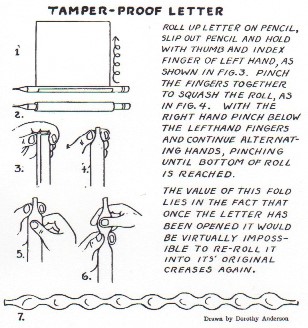| The Public Paperfolding History Project
x |
|||||||
| The Chickenwire Letterfold | |||||||
| This
page attempts to record what is known about the origin
and history of the origami design which I call the
Chicken Wire Letterfold in lieu of any more established
name (after the pattern of creases visible in the paper
when it is unfolded). Please contact me if you know any
of this information is incorrect or if you have any other
information that should be added. Thank you. ********** 1502 The first appearance of the Chickenwire Letterfold in the historical record is in the manucript 'De Viribus Quantitatis' by Luca Pacioli which was written in or around 1502. I have not been able to access the original document or an English translation but according to the dissertation 'Luca Pacioli and his 1500 book De Viribus Quantitatis' (which can be found at http://repositorio.ul.pt/bitstream/10451/18435/1/ulfc113829_tm_Tiago_Hirth.pdf) the manuscript contains a section on sealing letters without wax which says, inter alia: 'Another method is to have the letter wrapped around a round piece of leather. It is closed. The way it is closed is not to clear. However, Pacioli, stresses that there are special tongues with rounded tips to crease the letter shut. Upon opening the crease marks will be obvious making it a hard task to restore the letter to shut state.' It seems to me that this is a good descrip[tion of the Chickenwire Letterfold. ********** 1876 As far as I know the design next appears in the historical record in 'Des Kindes Erste Beschaftigungsbuch' by E Barth and W Niederley, which was first published in Bielefeld and Leipzig, and the foreword of which is dated October 1876.
********** 1891 The design also appears in 'Pleasant Work for Busy Fingers' by Maggie Browne, which was published by Cassell and Company in London in 1891. This book is an English version of 'Des Kindes Erste Beschaftigungsbuch' enhanced by the addition of a few extra designs. ********** 1961 The design reappears in Volume 2 Issue 2 of 'The Origamian' for Autumn 1961 as the Tamper-Proof Letter, which is said to have been shown to Lillian Oppenheimer by Irving Diamond, who had learned it from a Ukrainian friend.
********** |
|||||||

